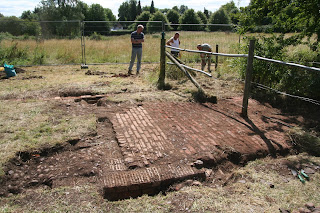We started off Saturday morning by trying to expose as much as possible of what we believed was a cobbled yard and brick floor of a building discovered in the closing stages of the dig last year. Saturday was spent tracing the line of several walls which gave us a lot more to puzzle about. On Sunday morning I suggested that two of the excavators try to see how substantial was one of the apparently well built redbrick walls. They fairly soon traced it down to at least six courses, and it had every appearance of a short stretch of ha ha wall. There was a similar wall of white brick on the opposite side. It was whilst pondering on what these walls could be, possibly more retaining walls than foundation walls, and also why they appeared to have laid a curved surface rather than a flat floor and why there were apparently no doorways, that it suddenly dawned on me that we were looking at a small humpback bridge over what was once a deep ditch which divides what I believe to be the Park “recreation” from the Park “agricultural”. The bridge is over 7 m wide and is accurately divided into two surfaces. One was a cobbled surface, presumably for stock to be driven over so they could get a grip, and the other half is thin bricks laid edge on presumably to give a smoother ride for a wheeled vehicle. I believe that what we were digging in last year i.e. brick rubble, slate, stones, etc was simply a spread of material laid down on either end of the bridge to give a firm and dry run up surface. Excavation on the side of the structure shows a rather crude culvert with the brickwork being corbelled. The core of the bridge seems to be a rather crude primitive concrete mix. I am not sure what you would like to do with this feature, but it seems to me that it is almost certainly 18
th-century and belongs to the original Park landscape. It almost certainly served the cattle sheds, but by its substantial nature may well have been a main route for crossing this dividing, or boundary ditch which has long since got badly degraded by the hooves of generations of cattle.








